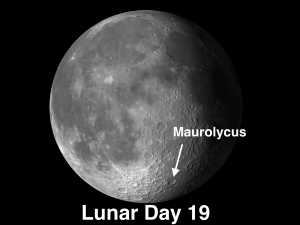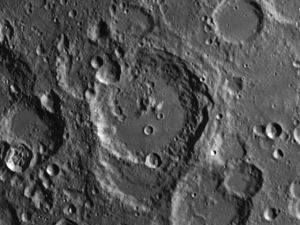The week of January 16-22 takes us from Lunar Day 19, just after full moon, through Day 24.
 This week we will highlight the crater Maurolycus, which rises at about 10:50 PM on Tuesday night. We are revisiting Maurolycus, which was featured prematurely on December 5th because the floor was still in shadow.
This week we will highlight the crater Maurolycus, which rises at about 10:50 PM on Tuesday night. We are revisiting Maurolycus, which was featured prematurely on December 5th because the floor was still in shadow.
Where Angels Fear to Tread: The Lunar Highlands
 Maurolycus: [SE/P11] Let us venture briefly into a region where angels fear to tread, the lunar Highlands. Plunge in and look for the crater Maurolycus. Although the area looks confusing, Maurolycus will be the largest and most conspicuous crater in this sector. It is a breathtaking sight under an early morning Sun and should not be missed. Maurolycus displays a rich diversity of different types of features. How many can you see? The central mountain peaks are so tall that they are illuminated long before the Sun finds its way to the dark floor. Also notice how Maurolycus overlaps a smaller unnamed crater on its southern border. This flies in the face of the rule that says younger craters are always smaller.
Maurolycus: [SE/P11] Let us venture briefly into a region where angels fear to tread, the lunar Highlands. Plunge in and look for the crater Maurolycus. Although the area looks confusing, Maurolycus will be the largest and most conspicuous crater in this sector. It is a breathtaking sight under an early morning Sun and should not be missed. Maurolycus displays a rich diversity of different types of features. How many can you see? The central mountain peaks are so tall that they are illuminated long before the Sun finds its way to the dark floor. Also notice how Maurolycus overlaps a smaller unnamed crater on its southern border. This flies in the face of the rule that says younger craters are always smaller.
======================
It is highly recommended that you get a copy of Sky and Telescope’s Field Map of the Moon, the very finest Moon map available for use at the telescope. It is available for $10.95 at www.skyandtelescope.com and on Amazon. All features mentioned in this blog will be keyed to the grid on the Field Map and will look like this: Plato: [NW/D9]
Credits:
Courtesy of Gray Photography of Corpus Christi, Texas
Lunar photos: NASA / USGS / BMDO / LROC / ASU / DLR / LOLA / Moon Globe. Used by permission
- Rupes Cauchy: A Best Known Fault on the Moon - July 22, 2024
- Moon Crater Schickard – Crater Floor has Stripes - July 15, 2024
- Moon Craters Langrenus and Vandelinus - July 8, 2024